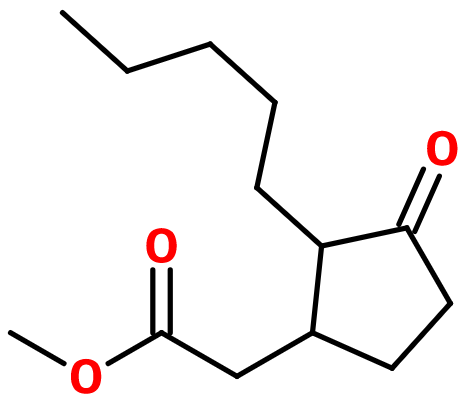Hedione®
Synthétique
Floral > Light Flowers > White Flowers

Crédits photo: ScenTree SAS
Other names :
Methyl Dihydrojasmonate ; Cepionate® ; MDJ Super® ; Kharismal® ; Methyl 3-oxo-2-pentylcyclopentane acetate ; Claigeon ; Jasmodione ; MDJ ; Methyl (2-pentyl-3-oxocyclopentyl) acetate ; Methyl 2-pentyl-3-oxo-1-cyclopentyl acetate ; Methyl (3-oxo-2-pentylcyclopentyl) acetate ; Supercepionate ; Paradisone®
Volatility :
Heart
Uses in perfumery :
Hedione® is used in jasmine reconstitutions, and all kinds of accords, to give volume to the whole, to accompany and give tenacity to the perfume. Allows, in association with Bergamot EO, Beta-Ionone and Damascone-beta, to recreate a tea note for example. Present in a large majority of commercial fragrances.
Natural availability :
Hedione® is present in trace amounts in Grandiflorum Jasmine Absolute and in some teas. It is nevertheless exclusively synthetic Hedione® that is used in perfumery.
Year of discovery :
Discovered in 1960, Hedione® was sold at that time for 7500 suiss francs per kilogram. This price really decreased.
Patent N°CH382731A published on feb 25, 1960 by Demole.E et Lederer.E for Firmenich et Cie.
''Hedione® '' tradename has been published and protected by Firmenich SA since 04/09/1972 (brand N°392334)
Other comments :
Data not available.
Price Range :
€€
Stability :
Stable in perfumes and diverse functional bases
Hedione® HC is quite unstable and tends to convert into trans-Hedione®.
Hedione® HC is quite unstable and tends to convert into trans-Hedione®.

Crédits photo: ScenTree SAS
- Molecular formula :
- C13H22O3
- Molecular Weight :
- 226,31 g/mol
- Density :
- 1,005
- Flash Point :
- 148°C
- Fusion Point :
- <20°C
- Appearance :
- Colorless liquid
- Log P :
- 2,93
- Boiling Point :
- 302°C
- Detection Threshold :
- Donnée indisponible.
Synthesis route :
Hedione® is synthesized from a condensation between cyclopentanone and valeraldehyde, followed by an isomerization of the intermediate product obtained to give 2-pentyl-2-cyclopenten-1-one. This molecule can undergo a Michael addition by reacting it with an alkyl malonate. A hydrolysis followed by a decarboxylation and finally an esterification (using methanol and an acid catalysis) of the acid function that has formed, allows to synthesize the final product, Hedione®.
Synthesis precursor :
The classic Hedione® is a mixture of isomers, it is used to isolate Hedione® HC (High Cis), a superior olfactory quality and power (also to be notes : Cepionate®, Kharismal® and Paradisone®)
Isomerism :
Hedione®, commonly used in perfumery, is actually a 9:1 mixture of trans:cis diastereoisomers of the molecule. However, cis-Hedione® is the most powerful isomer. Its detection threshold is seventy times lower than trans-Hedione®. Thus, some Hedione® enriched in cis isomer are marketed: Cepionate® (30% cis), Kharismal® (60% cis) and Hedione® HC (for ''high cis '') (75% cis). Nevertheless, this Hedione® tends to be more unstable than the classic Hedione®, as it isomerizes in its trans form, more stable. Hedione® HC is prepared by a specific distillation technique that involves sodium carbonate. Another method is to hydrogenate the corresponding cyclopenteneacetic acid by a ruthenium II catalysis, followed by a methanol esterification of the acid function.
- EINECS number :
- 246-495-9
- FEMA number :
- 3408
- JECFA number :
- 1898
- FLAVIS number :
- 09.520
- Allergens :
- This ingredient does not contain any allergen.
- IFRA :
- This ingredient is not restricted
To learn more about IFRA's standards : https://ifrafragrance.org/safe-use/library
ScenTree is solely responsible for the information provided here.

